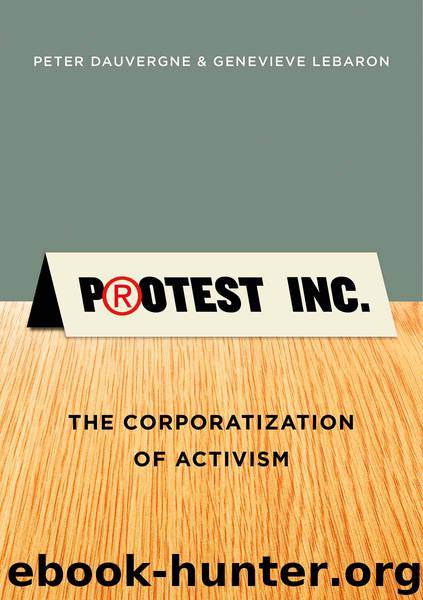Protest Inc. by Dauvergne Peter LeBaron Genevieve

Author:Dauvergne, Peter, LeBaron, Genevieve
Language: eng
Format: epub
Publisher: Wiley
CHAPTER FIVE
Institutionalizing Activism
The brand of a nonprofit organization can be worth billions of dollars. Amnesty International has one the world’s most trusted brands. So does WWF. In Europe, both Amnesty and WWF have ranked among the top five most trusted brands in the annual Edelman Public Relations survey, right beside industry titans such as Microsoft and Michelin. Overall trust of NGO brands in the 2012 Edelman survey was ahead of business and the media – and far ahead of governments. For five straight years (2007–12) NGOs have managed to top the Edelman survey as “the most trusted institution in the world.”
Brand recognition and trust of an advocacy organization can rival the McDonald’s M or the Nike swoosh. A trusted brand helps NGOs to recruit volunteers. It opens doors to policymakers and the media. And it enhances their legitimacy within communities. A trusted brand helps as well with door-to-door fundraising and corporate sponsorships. Big-brand companies have little interest in partnering with a no-name NGO. They seek out NGOs with “super brands” to strengthen trust and legitimacy of the corporate brand.1
Back in the 1960s most activists were meeting in classrooms or living rooms or churches. Most advocacy groups were casual and self-governing, with volunteers running campaigns. Activists strived to alter mindsets and embarrass firms and pressure governments. Even back then, many activists could see the value of fundraising to achieve these goals, especially as more and more causes began to compete for fewer and fewer high-profile news slots. Yet few, if any, 1960s activists would have foreseen the coming of NGOs with hundreds of millions of dollars in assets, thousands of staff, and CEOs with performance bonuses, all working through top-down bureaucracies to maintain a brand.
Who, fifty years ago, would have thought that one day most of the world’s human rights and environmental activists would be marketing causes and reporting back to corporate donors? Who would have thought frontline activists would be fired for refusing to conform to a management culture of efficiency? Or defend the brand image? Or demonstrate a return on donations?
Download
This site does not store any files on its server. We only index and link to content provided by other sites. Please contact the content providers to delete copyright contents if any and email us, we'll remove relevant links or contents immediately.
The Secret History by Donna Tartt(16606)
The Social Justice Warrior Handbook by Lisa De Pasquale(11485)
Thirteen Reasons Why by Jay Asher(7780)
This Is How You Lose Her by Junot Diaz(5753)
Weapons of Math Destruction by Cathy O'Neil(5029)
Zero to One by Peter Thiel(4816)
The Myth of the Strong Leader by Archie Brown(4785)
Promise Me, Dad by Joe Biden(4440)
Stone's Rules by Roger Stone(4412)
Beartown by Fredrik Backman(4403)
How Democracies Die by Steven Levitsky & Daniel Ziblatt(4392)
The Fire Next Time by James Baldwin(4336)
100 Deadly Skills by Clint Emerson(4070)
A Higher Loyalty: Truth, Lies, and Leadership by James Comey(4024)
Rise and Kill First by Ronen Bergman(4008)
The David Icke Guide to the Global Conspiracy (and how to end it) by David Icke(3875)
The Farm by Tom Rob Smith(3869)
Secrecy World by Jake Bernstein(3773)
The Doomsday Machine by Daniel Ellsberg(3725)
